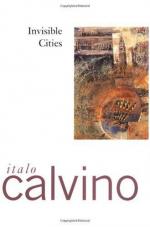
|
| Name: _________________________ | Period: ___________________ |
This test consists of 15 multiple choice questions and 5 short answer questions.
Multiple Choice Questions
1. Which city is said to be between two deserts, one of sand and one of water?
(a) Despina.
(b) Zaira.
(c) Diomira.
(d) Isidora.
2. When Khan accuses Polo of lying about the state of his empire, what does Polo say?
(a) He agrees the empire is sick and explains that is why he travels to the distant places.
(b) He has embellished every story in order to make it more appealing for the emperor.
(c) He insists that he has never, and never will, lie to the emperor.
(d) If the emperor does not want to hear the truth, then Polo's travels and tales will end.
3. By dissecting each city, what is Polo is trying to explain to Khan?
(a) That each city exists outside of its inhabitants and location.
(b) That there is good and bad within each city.
(c) That beauty is in the eye of the beholder.
(d) That not every city within the empire is relevant.
4. When Marco Polo meets with Kublai Khan, he:
(a) Describes cities that he's visited during his travels.
(b) Asks for a leadership position in the empire.
(c) Requests money to be able to continue his travels.
(d) Is worried that Khan will not approve of his stories.
5. Which city has supposedly languished and deteriorated, forgotten by the earth?
(a) Zirma.
(b) Isaura.
(c) Zora.
(d) Tamara.
6. Why does Polo initially rely on symbols to represent people and places?
(a) He's too shy to speak directly to the emperor.
(b) He wants to make it more challenging for Khan.
(c) He's eccentric and mischievous.
(d) He cannot speak Khan's language.
7. If a traveler walks into Zemrude with his head held down by grief, how will he see the city?
(a) Void of color.
(b) In decline.
(c) Brilliantly lit.
(d) From above.
8. Polo says that each action in Valdrada is inverted in:
(a) Another dimension.
(b) Its monthly plays.
(c) Its mirror image.
(d) The future.
9. When Polo speaks of a city, he speaks:
(a) With a stutter.
(b) With an air of great authority.
(c) Only what he thinks the emperor wants to hear.
(d) Of his own perceptions of the city.
10. When Polo first communicates with Khan, the emperor is able to:
(a) Look interested despite being bored.
(b) Comprehend his unusual accent.
(c) Decipher his signs.
(d) Understand everything completely.
11. Khan's messengers advise him on the price of:
(a) Materials found in his land holdings.
(b) Medicines imported from nearby regions.
(c) Purple cloth for his royal garments.
(d) New battle ships.
12. Polo explains that the city Khan dreams of with the farewells from its harbor has one secret. What is it?
(a) It is a phantom city born of nymphs' imaginations.
(b) Its residents suffer from a rare, mysterious disease.
(c) Other cities bring their prisoners here.
(d) It knows about departures but not returns.
13. Polo gives Khan impressions of:
(a) His cities and their inhabitants.
(b) The meaning of life.
(c) The financial state of the empire.
(d) What other leaders think of him.
14. After Khan sends Polo on many missions, Polo learns:
(a) To become an expert negotiator.
(b) How to sail virtually any type of ship.
(c) The language of the Tartars.
(d) The cooking techniques of the Mongols.
15. Which is the city of a thousand wells, sitting above an underground lake?
(a) Zirma.
(b) Isaura.
(c) Tamara.
(d) Laura.
Short Answer Questions
1. Khan tells Polo about his dreams of a city where the farewells from its harbor are what?
2. Once Polo is able to speak a language that Khan understands, he can:
3. At the beginning of Chapter 2, what do Khan's messengers warn of?
4. Someone traveling to Maurilia will be invited to what?
5. In order to really understand the language of Hypatia, what must Polo do?
|
This section contains 651 words (approx. 3 pages at 300 words per page) |

|




